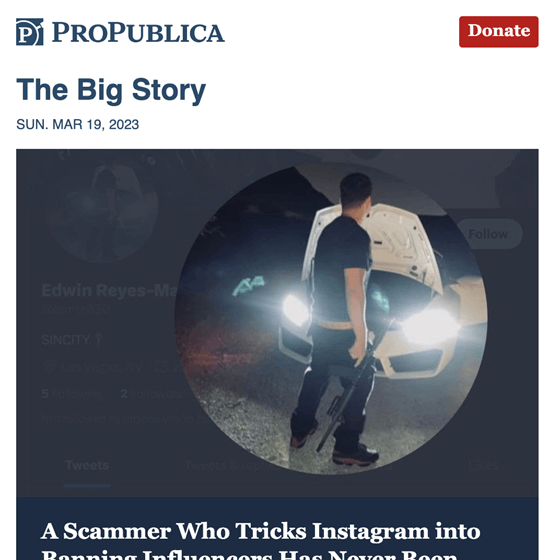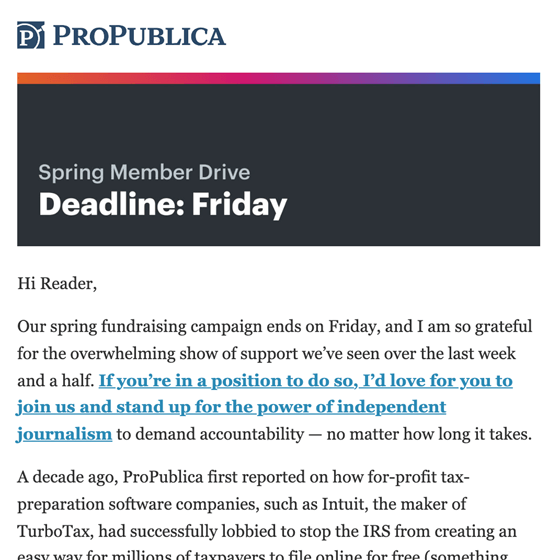Q & A: Jill Shepherd, ProPublica
Most people don’t like asking other people for money. It’s hard. It feels gross.
In my experience, this is especially true for journalists. However, as more newsrooms launch as nonprofits or lean into subscriptions, the skills to raise money from individual readers gets more important every day. Persuading people to pay for journalism is a tough job, but we all have to help the effort.
I want to help newsrooms learn how to level up their reader revenue strategies, so I reached out to the best fundraising person I know: Jill Shepherd, ProPublica’s Director of Online Fundraising and Outreach.
I worked with Jill at ProPublica in 2017. She taught me at least 98% of everything I know about fundraising and donor strategies. She makes things happen, and it’s amazing to watch.
During our conversation, Jill shared so many incredible insights! She shares her experience about building a predictable donor machine at ProPublica, the concept of converting people mentally before converting them to donors, and so much more.

Meet Jill Shepherd
Since 2017, Jill has run ProPublica’s online giving program. Before that she ran WBEZ’s membership program. She’s a big fan of nonprofit journalism.
Cory Brown: You are in the middle of the ProPublica spring campaign. How’s that going?
Jill Shepherd: It’s going great! One thing I’ve learned is that newsletters are definitely our best pipeline. Our newsletter-to-donor pipeline is resilient, and we have turned it into a kind of well-oiled machine, as I had hoped from the outset. It’s quite predictable.
How long have you been at ProPublica? You started a little bit before I was there in 2017, correct?
Yeah, I started in early 2017.
How have newsletters become part of that well-oiled machine? How has that machine evolved?
When I started at ProPublica, my background was in public radio. I was director of membership, and I ran the pledge drives for years at WBEZ in Chicago. I learned that pledge drives raise so much money, everybody hates them, it’s a ton of work, but they behave in very predictable ways. As long as you’re saying what you’re supposed to say, they work predictably.
At some point, we realized that the same idea as pledge drives might work in other ways. We did a Kickstarter campaign with Vocalo, which is WBEZ’s sister station. The audience we were shooting for is not your typical NPR audience, so we didn’t want to subject them to pledge drives. Instead, we did a Kickstarter campaign, and it behaved in a very similar manner. And I realized, oh, campaigns are campaigns, no matter the channel.
I was itching to try this in a digital format instead of radio because radio pledge drives hold the audience hostage. It’s really hard. Nobody’s your friend. They are groaning, “Oh, here you are again. I get it, and I love the programming, but these drives are awful.”
When I arrived at ProPublica, I immediately said, “We’re doing quarterly campaigns.” I think at that time, there were only a couple of newsletters.
Yes! It was only two regular newsletters, one daily and one weekly.
They were run by the engagement team, who were wearing 1,000 hats then. They still are. They didn’t have the capacity to take on the extra work, so newsletters weren’t a big priority, then.
Anyway, I did a campaign soon after I started. We put some messaging up on the website, on social media, especially Twitter, and we sent out the same messages over email to our past donors and newsletter subscribers.
It worked, but we’ve all been learning together. Like, how aggressive could we be? Email proved right away to raise the most money from the most donors.
These days, I email our folks about ten times in twelve days, four times a year—more than that in December. Email is where most of our money is coming from.
We implemented conversion tracking tools, and you see more detail. We have a bunch of people give online, but how many of those people did we ask through email?
The answer to that is 70% — 70% of the donors from our website have ALSO been asked to give by email Email is, hands down by a mile, our most lucrative channel.
Earning five minutes of your time is a big ask. That’s why we apply these persuasion principles when we can.
There are seven of them, and they all matter.
Email is great because it’s one-to-one. It’s a real opt-in. Email subscribers are addressable. People think, “Here is my email address, I trust you.”
A third-party does not mediate email. These days it’s a one-to-one relationship instead of trying to talk to you through Twitter’s recommendation algorithm.
In these emails, I spend a lot of time making my case for supporting ProPublica. We give people ways to opt out, but we also let them do what we call “opt down.” If you go to the bottom of an email, you’ll see some copy that says, “We’re nonprofit, and we get most of our money from people. If you don’t want to get solicitation emails, click here. You’ll still get your regular newsletters.”
Do you get a lot of opt-downs?
2% of the people from a campaign click that button and opt down. They still get newsletters. When I look at that audience segment, plenty of those people give. They don’t want to hear from me. That is super fair! I love that they can self-select. Our opt-out rates are very low, about .15%, but it’s very likely because 2% choose to opt down.

You said ten emails in twelve days. Does that burst of emails have a different effect based on the newsletter frequency? Do the weekly people get a little overwhelmed while the daily people are not?
Once we found out that email was a lucrative channel, Celeste LeCompte [Former ProPublica VP of Strategy & Operations, currently Chicago Public Media Chief Audience Officer] and the leadership team invested money to hire Ruthie Baron as newsletter editor. Among many other wins, she built out Big Story, the one flagship newsletter product we use to gather people into a useful, addressable pipeline.
Even though things were going well, you could just see all the metrics level up after Ruthie shows up.
Where do you draw inspiration from for your campaigns?
I get a lot of my inspiration from just digital marketing. I actually sort of stay away from publishing most of the time. I look at what the content marketing people are doing. Or even software companies and small businesses. They are all trying to figure out how to sell stuff, and a lot of them have developed content marketing formulas.
For example, I read somewhere that a lead should receive content marketing about a product 80% of the time, and sales messages to buy the product 20% of the time.
from the library
ProPublica Big Story Newsletter 2023
See the full Big Story email and other daily newsletter examples in the 99 Newsletter Project Library.
I thought that was revealing, so I ran a quick report to see what types of messages people were getting at ProPublica, newsletters vs. marketing emails. Yes, I do bombard them, but it’s only for two weeks. And honestly, it seems okay. If you only get the weekly newsletter, you get a way higher ratio of campaign messages than people who get the Big Story or the daily newsletter. But it still isn’t 20%, and it doesn’t seem to be a problem, so I haven’t spent any more time focusing on that.
But, on the other hand, it made me wonder if there’s maybe some low-hanging fruit we are missing. So the priority became asking if we had room to email some people more. Could we increase campaign messages to daily newsletter subscribers to get them closer to 20%? But largely, the subscribers of the different newsletters all behave similarly enough that I count them as one big group of newsletter receivers.
What is your campaign planning and goal-setting process?
With public radio, I would sit with a goal map and ask, what did we do last time? What is the pulse of the conversation in the country about the news that matters? Sometimes Trump gets elected, and sometimes, there’s an insurrection. Sometimes there’s a pandemic. But sometimes it’s more chill. People are acting more business as usual.
So to set a goal, you would take your past performance and increase it by a bit, depending on both the audience’s attention, and the audience size — is the audience the same, bigger than, or less than before? You see how that works.
Several years ago, we wanted 1,000 people to donate to each campaign. My bosses were comfortable with that number, and it seemed like a safe enough bet. But because it was so new, it was very hard to make a strategic goal beyond that, so we just kept going and collecting data.
That led me to avoid publicizing goals as much. It doesn’t seem to have much of an impact.
Get the next Q&A as soon as it drops +
real newsletter breakdowns, step-by-step guides and more
If you look at a breakdown of a campaign, about 40% of the people show up in the last couple of days. So many people show up at the end! So it’s hard to see how a campaign is going before it ends. You’re wondering, are we going to hit the goal? But you don’t know until the end. For the audience, if I hit the goal early, that’s less fun and impactful, so I don’t publicize it
People aren’t saying, “Do you need ten more people? Because if you need ten more, I’m going to show up. But if you don’t need ten more, I’m good, and I’ll sit this one out.”
They’re not paying attention that closely. Instead, I let them know today is the last day. Then that 40% shows up. It’s as much about the deadline of time, than the hitting of a goal, you know?
In between campaigns, we have renewals going out all the time. So other donor activities are happening, but largely all of those feed into December, which gets exponentially larger. 30% of my revenue shows up in December.
ProPublica is different because we aren’t a daily news source. People do not come to our website every day.
But when we have big stories, everybody’s like, whoa, this is huge. They remember those big stories. The fundraising tail of our big stories or investigative work lasts for a while.
When December comes, it’s like the end of a campaign and so many people show up. But again, I email people a lot. So I am reminding you all the time. But a lot of people are already convinced “mentally.” That’s the word I use, I’ve converted them emotionally. Now we just got to get them to take out their wallet, and convert them, “actually.”
That’s an interesting concept, converting people emotionally before converting them to enter their credit card number. What key motivators flip that emotional switch?
They are called persuasion triggers. And the father of that is Dr. Robert Cialdini. He’s a psychologist and author at Arizona State University. He wrote Influence: The Psychology of Persuasion and several other books on persuasion.
He figured out all these triggers and named them. It’s very helpful! A very common one that you’ll see is scarcity. Think about when something is in limited supply, like when we only have 20 t-shirts to give away. That’s scarcity.
If we’re giving away a perk, I don’t like to count down the quantity. I prefer to offer the perk on one day only. “Give $100 this Tuesday, and we will give you a ProPublica t-shirt.”
I promise you, nobody thinks the t-shirt is worth a hundred bucks. It’s because they’ve been meaning to donate for so long, they’ve been mentally converted. The scarcity then kicks in because there’s only one day when you can donate and get the t-shirt.
There is also the reciprocity principle. You gave me something, so I’m going to return the favor. Scarcity and reciprocity get people into action. It gets people thinking, “I’m going to find five free minutes today and give them to you.”
And frankly, for our readers, that’s the hard thing.
Time is hard. Getting people to give money is hard.
Earning five minutes — it’s really only three minutes — of your time is a big ask. That’s why we apply these persuasion principles when we can. There are seven of them, and they all matter. All of them aren’t always available to you. We don’t always offer a t-shirt. If we did, that would lessen the impact of that t-shirt. We try to use them when it will get people rallied up and donating.
Recently, you commented on a LinkedIn post about how people or donors don’t necessarily act linearly. I often see people think in terms of, I’m going to send my subscribers X number of emails to get Y response, but it doesn’t work that way.
You commented that there is no correlation between people who open your fundraising emails and donate. Lots of people open and don’t donate. Plenty of people donate, and yet, don’t open emails.
How does that affect how you put campaigns together?
The original LinkedIn post was from Andy Crestodina. He is a long-time professional acquaintance of mine. He’s given me lots of free advice over the years. Journalism is lucky that he has given us such great advice.
Funnel behavior is so frustrating. Colleagues often ask, “What email did the best?”
And I have to tell them that’s not how it works. I wish that it were that simple.
But whenever I look into the data to find something amazing, the data always shows…everybody did a little bit of something. Before Apple’s privacy policy update, I would look at these open rates going back for years. When I first started, I ate up all the data I could. Coming from radio, this is a whole new and different set of data.
We look at things like how long a campaign email lasts. An email tail is about 24 hours. After that, most people don’t read that email anymore.
In that 24 hours, are they giving to that email? What are they doing? And so when I looked at all the people who gave and opened or didn’t give or didn’t open or whatever, it’s all a jumbled mess. They all look the same.
The average number of opens during my campaigns is one. One! And lots of people who don’t give open emails, too.
One email open out of ten emails?
One out of ten, or even one out of 30!
Here’s the thing about that. The reason why we need quarterly campaigns is that we have to keep beating the drum. I must keep saying it because nobody wants to listen to campaign messages. I am an interruption in your day! (laughs) You might love ProPublica, but do you really want to hear me talk about supporting it?
My husband has a great analogy for this. It’s really hard for people who work in journalism to step back and see things the way our readers see us.
He says it’s like a park.
I walk past four parks on the way to work. I might know the name of one of them. I take walks in these parks. I bring my dogs to the parks. Some have playgrounds, but honestly, I don’t know who owns them. Is it the park district? My favorite one down the street is a forest preserve. I don’t even know how that’s different. They are all parks to me.
I think most people approach journalism similarly. They love an article, or they like the writer, but they don’t particularly know the ins and outs of our industry. And they don’t care to know. I just want to get dinner or go pick up my kids from school. There’s just not a ton of time that I have to give you my attention.
Now take a million people, put them together on a newsletter list, and try to see if they behave in some linear way. They don’t.
So my job is to repeat myself all the time. I do quarterly campaigns. If you’re going to read one of my emails, I’m going to make sure it’s an awesome email. I will send you thirty, but I will be happy if you read one.
And you know what? You are seeing 30 different subject lines for a good product that you value. All those subject lines don’t make you think, “eff off, Jill.” They keep the drum beating.
If you don’t like them, then you opt out. It’s cool. But for the most part, people aren’t bothered and many are convinced to donate someday.
Finally, there’s the day I offer a t-shirt or we publish an amazing story. Then they finally chip in.
There’s another principle that I like to apply: salience. I’ve learned at ProPublica that salience matters. If you do something very relevant today and you stay laser-focused on that, it helps a lot.
Seeing ProPublica stories on the news or you hear our story on NPR helps make those campaign messages work. All those subject lines, plus that one campaign email per quarter you read, all work together.
Marketers call them touches. How many times do you need to touch somebody? A subject line is a good enough touch for me. Or a social post, that’s fine. There’s no data that I can attach to one of those things.
But when I look at a year’s worth of data, it all adds up. I promise that a lot of the donors who show in December would not have done so without being subjected to the touches of the three campaigns that preceded it.
That gets frustrating. Our colleagues at smaller newsrooms get freaked out. They will do a campaign like Giving Tuesday or NewsMatch, and it starts off awesome. Then everything drops dead.
I’m the person who tells them to stick with it. You have to be a cheerleader. Make your arguments. They are getting through to people, even if they’re not saying anything or taking any behavior right now. Many of them will show up in December.
We’ve tried to cut down pledge drives. It’s terrible. We’ve tried to cut out the middle and just keep the December 40%. It does not work. You can’t cut out the middle. You have to do all of it. You have to touch them as many times as it takes. You can’t just fast-forward to that last bit with the deadline.
You have to build your momentum, and it has to happen authentically and organically.
I’m a huge fan of repetition. I sometimes find that journalists, especially, get a little wary of saying the same thing twice. Do you reuse and repurpose actual email content?
Sure I do! Other places do this, too. We weren’t the ones to invent this. It’s not that we’re using the same email, although sometimes we do. But more often, we’ll use components of an email again, or rearrange things, etc.
So many people skim an email — the main point is that we’re asking for money. You should support us. That’s the thing I’m repeating over and over again. You should support us.
“Hey, Cory, you should support us.”
“Cory, you should support us. Do you think maybe today’s day that you will support us?”
“I think today’s day. You should support us.”
That’s what a lot of folks are reading from it. I hope that I have more of their attention, and if I do, I’ve got more to say. Like, Have you seen our TurboTax reporting? We’ve been covering it for ten years. Can you believe this about TurboTax?
The TurboTax Email is one of my favorites. I love it. I think it’s great.
Thank you. It’s a big performer. I’m going to do it again, even though we’ve done it before. It hooks.
from the library
ProPublica TurboTax Fundraising Email 2023
See the full TurboTax email and other nonprofit newsroom fundraising examples in the 99 Newsletter Project Library.
So what do you do if a campaign underperforms? Where do you look to diagnose where it missed the mark?
I can’t say that any of our campaigns have underperformed because, for the most part, we’re doing as well as last time.
During the pandemic, we canceled the spring 2020 campaign. We put up some more website messages that said we are a nonprofit, but we didn’t have a real campaign.
But because we get traffic spikes, we did get a lot of donations during our COVID coverage. Mostly because we were covering stories that showed salience, which was so valuable.
Then people who were mentally converted showed up.
When we had a campaign in May, that was only four days. We participated in that Giving Tuesday Now campaign in the early pandemic, and that one performed very well.
The next year did not do as well. But we wouldn’t say it underperformed. I would say the summertime in 2020 overperformed. I always have the lowest expectations for summer campaigns. It’s tough. People go on vacation in the summertime. You don’t want to try to get people to do stuff in the summer.
But I’m not going to stop my drumbeat. Whoever is available to listen to me, great, I’ll take those people.
Summertime in 2021 was when we launched our secret IRS files series. That campaign had much higher than expectations because we had this coordinating traffic spike. It overperformed our usual summer campaigns.
How does onboarding play a role in your campaigns?
When it comes to acquisition, when we have a traffic spike, then we get more sign-ups for the Big Story newsletter. This is because Ruthie is so good at her job.
When they sign up, we send them onboarding messages. Dr. Cialdini calls it priming. That was his newest book.
When I onboard a new subscriber, I tell them this is ProPublica, this is how we are funded, and these are our best hits. You should read these stories. You might remember them.
When you look at when those new people give, they give during campaigns.
Of the people who give, 15% do it after one campaign.
Another 15% do it after two campaigns.
Another 15% do it after three campaigns.
That is evenly divided amongst all the campaigns. But you need the campaigns.
What is something you worked on recently with a surprising result?
I’m a one-person team. I put aside some time to get into the 2022 data, especially because 2022 was another business-as-usual year. There was no pandemic. There was no insurrection. There was no big story that much of America was laser-focused on.
One very evident thing was newsletters are an excellent pipeline. When you look at campaign to campaign, we concentrate much of the giving in the campaigns. And so then, when you ask how was traffic yesterday? And how was giving yesterday? There’s no relationship. But when you look at it from the last five years, there is a relationship. And the newsletter pipeline is stronger.
What that tells me is all that repeating ourselves is working.
There are four specific things that I’m trying to tell a person about ProPublica before I think that they’re mentally converted. It’s really specific, and it comes from a variety of research.
Some of it is Dr. Cialdini, and some of it is public radio research. But one is that you have to value it. Think about the parks. Nobody sits down and says, “I really love that ProPublica.” or “I love this park, I must find out how it is funded.”
I’m going to have to say, “Do you really love ProPublica? You love ProPublica.” And then people realize, “that does describe me.”
Or it doesn’t. Maybe they hate us. Those people opt out.
But I need you actually to acknowledge that you value the service. And then you have to establish a shared identity. “We are independent. We are a nonprofit. We’re not corporate. There are no shareholders.”
If you’re a city newspaper or WBEZ, you are a Chicagoan. “We are Chicago’s news source.”
You need to establish a variety of shared identities. “We’re like you. We’re your people, and you are my people.” We are on the same team in some way.
The next two things are easier. “We need money. How are we funded? How much money does this cost? Is it time-consuming and expensive to do investigative journalism?”
Lastly, “we need money to come from people like you. Lots of our readers donate to support us. Join over 40,000 donors.” All those things really matter.
People need to understand those four things before a t-shirt will ever enter their minds.
I’m using examples, but those are the four points I’m hitting every time. If you read my emails, I can highlight for you all those things that are hitting those four points. It’s everywhere.
This post was edited for length and clarity.
Get more expert insights for building
strong relationships with your audience in the 99 Newsletter Project newsletter:
You can opt-out at any time.
For more details, please review the Terms of service and Privacy Notice.








